#acadian folklore
Explore tagged Tumblr posts
Text
I started reading Llewellyn’s Complete Book of North American Folk Magic today, and usually these books on “North American” magic don’t have anything at all about Canada, and if they do, it’s one or two mentions of like “hey yeah, Canada is in North America and they’ve got witchcraft too!” But they rarely have any substantial info. Which is a bit frustrating as a Canadian witch, but I’ve learned to deal with it and work with the limited info I can find.
Anyways, this book opens with a chapter on French Canadian magic (Sorcellerie). The two authors—creators of the Courir le loup-garou blog about French Canadian magic, which is a wonderful and bilingual resource—describe a brief history of French Canadian people and the context behind the historical folk traditions they were a part of. And then they get into a discussion of what some of those traditions and practices were, what their uses were, and so forth.
I wasn’t expecting to read anything about my Acadian ancestors’ traditions in this book, and reading it made me a bit emotional because it’s just so rare to come across this information, let alone in an accessible book like this. The Acadian side of my family have become very disconnected from our culture over the last fifty-so years, largely the result of a lot of complicated historical stuff that went on. The last two generations (me and my mum’s generation) don’t even speak French. Nowadays, being bilingual is a massive source of pride in Canada, but knowing French wasn’t always a positive, so it wasn’t passed down for that reason.
Over the last year or so, my practice has shifted a bit from largely eclectic and neo-pagan to a calling to explore the traditions of my ancestors, many of whom are Acadian. But with that has come a difficult realization: since I don’t know French, a lot of the existing sources on sorcellerie aren’t accessible to me. Which is fair enough, and one of the reasons I’m trying to learn the language, but sad when taken in context with the gradual loss of culture in my family.
All of this to say that while I’ve only read the first section of the book (the essay on Sorcellerie) and have no idea how the rest of the book is, reading this chapter about the traditions of my Acadian ancestors was very beautiful and healing, and if you’re trying to reconnect to those traditions like I am, I really recommend reading this essay. I’ve learned a lot and have a few jumping off points now for further research, which is always so exciting!
#folk magic#sorcellerie#french canadian folk magic#acadian folklore#acadian folk magic#canadian folk magic#french canadian witchcraft#acadian witchcraft#books#ancestors#my post#Llewellyn’s Complete Book of North American Folk Magic
13 notes
·
View notes
Text
Folk Ways for an Acadian or French Canadian folk practitioner
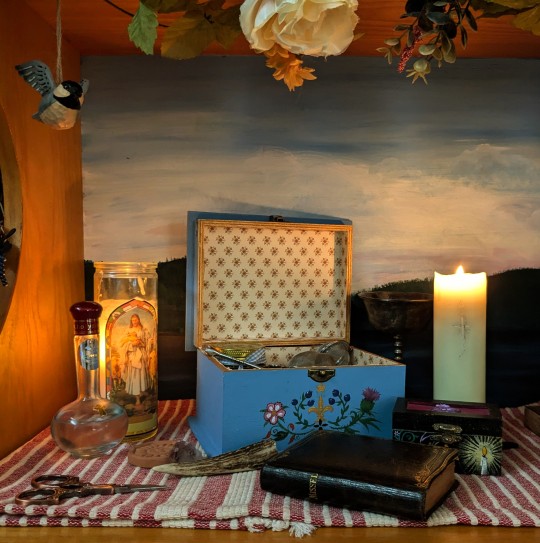
I want to start an ongoing list of Acadian and French Canadian religious and popular folk ways that I've been learning about for the last two years. My references will be at the end for further reading!
Blessing a candle on Candlemas (Feb. 2) with holy water will allow you to have a light whenever there is sickness and storms hitting your home. Traditionally on Candlemas, the light is lit and guided through every room in the house to bless all its corners for the year. It was even paraded in the farmer's fields. (Dupont)
The 25th April, on St. Mark's Day, is the ideal day to bless your fields or garden before putting in the first seeds. This ensures the growing food to be blessed by this saint. (Maillet)
Animals have been known to speak in human tongues on Christmas Eve. (Maillet)
If you feel that nothing is going right in your day, your homemade bread sours, or general bad luck assails you, simply boil some holy medals. (Dupont)
The first three days of the month of August, the ocean waters are known to have healing properties, and it wouldn't hurt to dip your feet in it. (Chiasson)
It was customary to trace crosses on windows using holy water when a storm would hit. (Lacroix)
To find a lost object, simply toss a rosary or a pocket metal rosary over your shoulder. The foot of the cross will point in the direction where your lost object might be located. (Dupont)
To have good weather on your wedding day, be sure to hang your rosary on your clothes line the day before. (Dupont)
Maillet, Antonine. Rabelais et les traditions populaires en Acadie. Les presses de l'université laval, quebec. 1980.
Lacroix, Benoit. Folklore de la mer et religion. Editions Leméac, 1980.
Dupont, Jean-Claude. Héritage d'Acadie. Collection Connaissance, editions Leméac, 1977.
Chiasson, Père Anselme. Chéticamp: histoire et traditions acadiennes. Editions des Aboiteaux, 1972.
#christianity#witchblr#folk magick#french canadian#acadian#quebec#folk magic#witchcraft#acadia#canadian
54 notes
·
View notes
Text
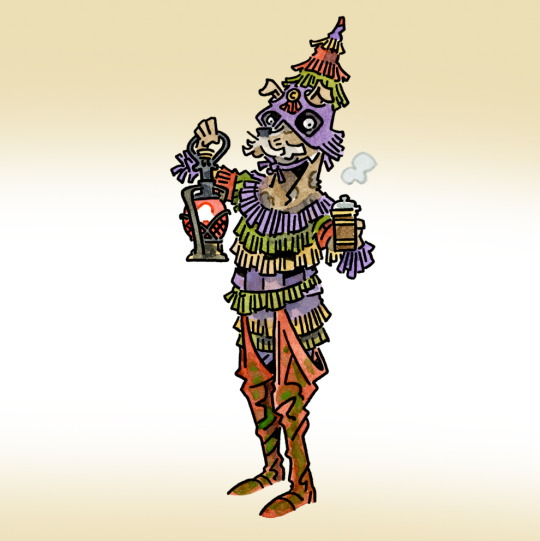
Companions of Christmas day 7: Guinefort, the Cajun Rougarou When Santa Claus visits the bayous of Louisiana, the dense canopy of trees that blanket the rivers along which its people live preclude him from employing his reindeer-pulled sleigh. He has instead taken to using a pirogue, a type of flat-bottomed boat, and in lieu of reindeer employs the services of eight charitable alligators.
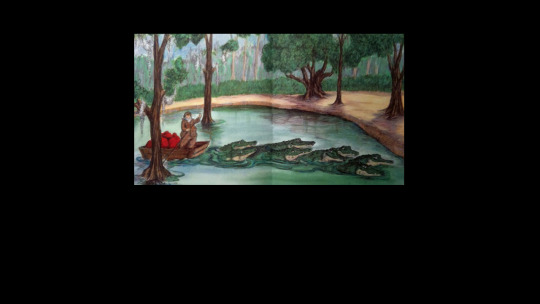
The people along the bayou’s rivers light bonfires on the bank each Christmas Eve to help Santa find his way.
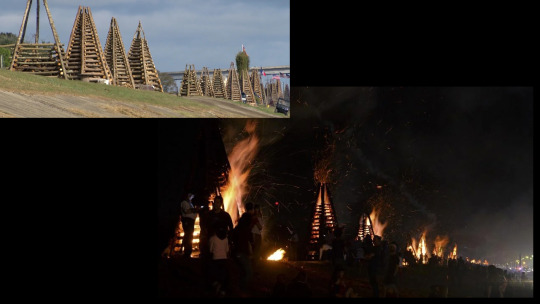
But those settlements, and the cabins and houses between them, are spread out enough that the oppressive darkness of the waterland often persists for long obstacled stretches.
Luckily for Santa and the children of Louisiana, he is assisted along these stretches by a Rougarou, a type of werewolf, whose real name is not known, but whom the Acadian locals calls “Guinefort” after St. Guinefort, a popular saint in France who happens to be a dog.
The Cajuns were always wary of Guinefort because it is, after all, prudent to be wary of wolves, but knowing that his birthday was Christmas (because, as many know, only those born on Christmas can be cursed to become werewolves), people would leave him treats and presents on that day, so Guinefort came to love Christmas, because it was the day that he felt loved himself.
Now, the furry Cajun makes the most of his agile nature and keen night vision to help Santa navigate the sometimes treacherous waterways, standing on the backs of Santa’s alligators and serving as a pilot, avoiding submerged logs and Cypress roots while sipping hot chicory and casting a warm glow with his red lantern.
••••••••••••••••••••••
Happy December, friends! Each year around this time I post up drawings of Christmas and other winter holiday figures, along with narratives to explain the practices with which folklorists and holiday buffs might be familiar. When stories exist, I use them; when they don't, I do what I can to piece together what folklore surrounds them to fill in the gaps (or, in some instances, defer to the theories of my friend and fellow narrative reconcilianist Benito Cereno). I hope you enjoy them!
#Guinefort#Papa Noel#Rougarou#Werewolves#Werewolf Art#Christmas Art#Folklore#Cajun Folklore#Louisiana Folklore#Christmas Around the World#Christmas Traditions
106 notes
·
View notes
Text

🕒 When: Today
📍 Where: Library at UMWR
👥 With Whom: Henri O’Dea and a NPC Archeology Professor
🔹 Summary: Henri works at the library (UMWR) on Netherville. A study in character of sorts.
At this hour, the library at the University of Wicked’s Rest was near empty save for the irregular sound of pages turning, the quiet scrape of chair feet on carpet, the distant tinker of the tired neon lamp in the anthropology section.
In the air hung the scent of paper and detergent, the sort they wiped every table with right before closing.
It was late, yes, but Henri O’Dea was still here, sitting at the most remote table with stacks of books piled precariously around him and a notebook that could only be defined as well loved, its worn cover guarding hours of research carefully collected and scribbled in by the archeology student.
To the casual bystander, the young man seemed like a regular student, albeit a rather hard working one, but if one were to take a closer look at the books, you could begin to wonder what kind of course he was following: Legends and Lost Settlements of New England. The Tides of Wicked’s Rest. Haunted Waters: Maritime Folklore of the Maine Coast. Pages had been marked with post-its, each of them scribbled with more notes and Henri’s pencil still moved swiftly on paper now.
He was not studying.
Henri was hunting.
His finger traced along a map of Wicked’s Rest. A century old and definitely not nearly precise enough for day to day. Google Maps would have been his go to, had it not been for the location of the monster he was hunting. Bleak Point was written on the map in beautiful capital letters, the faded ink giving charm to a part of town he personally considered to be against nature. Henri had nothing against the supernatural, or magic. He found it quite beautiful, really. But, when it served as an excuse to commit the most awful and selfish of crimes (on his fellow hunters or the supernatural beings side), he had to intervene.
In this forsaken part of town, something was stirring. Three people had disappeared in the past couple of weeks, all in the same street (could a tunnel be considered a street?).
A moving shadow caught the corner of his eye. With one leg moving slower than the other, Professor McAlister was easy to recognize without even looking up. The balding man was a respected historian, known mostly for his work regarding pre columbian populations from the Acadian coast down to New England.
“Still chasing ghost stories, O’Dea?” McAlister’s voice was light, almost amused, but his eyes flicked over Henri’s notes with too much interest.
The young man casually picked up a book he’d been using to keep the map from rolling closed, setting it on the most damning scribbles on the desk. “Research.” He replied, his voice even. “I’m looking into Bleak Point. Huh… Netherville.”
The professor offered a compassionate smile, but Henri could have sworn he caught worry in there too, especially as the old man opened his mouth: “Local history then. Funny thing about history… It has a tendency to swallow people whole.”
Stern as ever, Henri met the man’s gaze. “And it’s an archeologist’s job to know how to dig. Lucky me.”
With a quiet chuckle, the professor raised his shoulders and wished Henri good luck and good night, before he turned around, the sound of his feet familiar as ever while Henri watched him disappear down the aisle.
9 notes
·
View notes
Text
Mysteries Of The Bayou: Cajun Folklore And Legends
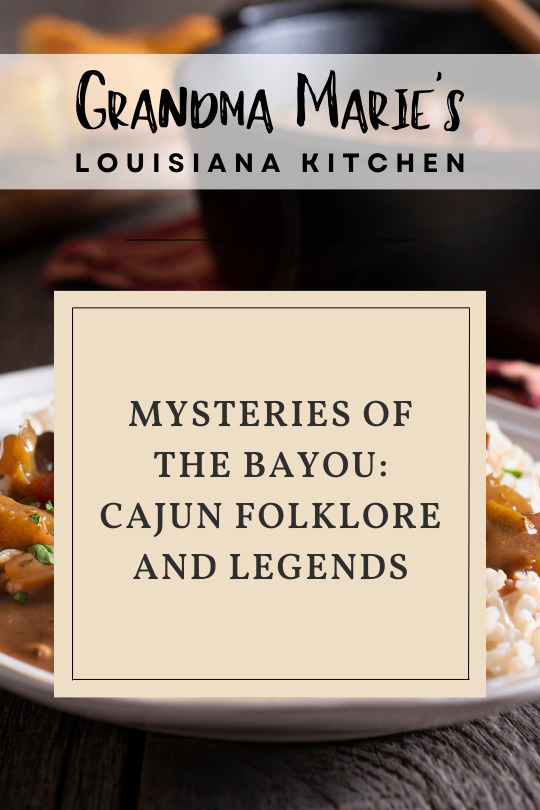
Ah, settle in, dear ones, as we embark on a journey through the mystique of the bayou, where whispers of Cajun folklore and legends weave tales as enchanting as Spanish moss draping the cypress trees.
The Rougarou Let me share the tale of the Rougarou, a creature of the night with a taste for mischief. As the moonlight dances on the bayou waters, locals speak of this shape-shifting beast – a reminder to keep the sacred traditions alive and be cautious when venturing into the unknown.
The Feu Follet Look closely on a moonlit night, and you might glimpse the Feu Follet, the mischievous "will-o'-the-wisp" leading wanderers astray. Cajun storytellers say these elusive lights are spirits guiding lost souls, adding a touch of magic to our bayou nights.
The Legend of Evangeline In the heart of Cajun history, there's the tragic tale of Evangeline, separated from her love during the Acadian exile. Her spirit is said to linger in the shadows, seeking her lost Gabriel along the moss-covered paths of the bayou.
Papa Legba Among the whispers of the bayou, the voodoo spirit Papa Legba guards the crossroads, offering guidance and challenges to those seeking mystical wisdom. His presence is a reminder of the rich spiritual tapestry woven into our Cajun heritage.
The Ghostly Isleños Travel to the haunting swamps, and you might hear the echoes of the Ghostly Isleños, Spanish settlers who mysteriously disappeared. Some say their spirits still linger, casting a spectral presence upon the bayou's edge.
The Sacrament of the Gris-Gris Deep in the bayou, crafting Gris-Gris bags is a mystical art. Passed down through generations, these enchanted pouches are said to bring protection, luck, and even love to those who carry them.
As the night settles over the bayou, these stories come alive, mingling with the sounds of crickets and the distant call of an owl. Our Cajun folklore, rich and deep-rooted, whispers through the moss-laden trees, inviting us to embrace the mysteries that dance on the edge of our vibrant culture.
Next time you find yourself by the bayou, listen closely – for it might just share secrets and tales of our Cajun ancestors, keeping the spirit of Louisiana alive in every rustle of the leaves and every ripple on the water.
Gather ‘Round The Campfire
Imagine the crackling flames of a bayou campfire casting dancing shadows as we gather to unravel the Mysteries of the Bayou. To accompany these tales, let us weave a tapestry of campfire activities and comforting Cajun delights, creating an enchanting evening under the Louisiana stars!
Campfire Activities
Bonfire Storytelling Circle Gather 'round the bonfire, my darlings, and let the bayou come alive with tales of voodoo queens, haunted swamps, and friendly spirits. Everyone can share their favorite Cajun folklore or ghost story, adding to the night's mystique.
Cajun Campfire Sing-Along Enliven the atmosphere with the lively tunes of Cajun music. Bring out the accordion or play some zydeco favorites. Let the rhythm of the bayou set the tone for our storytelling, making it a musical journey into the heart of our culture.
Bayou Night Walk Take a lantern-lit stroll along the bayou's edge, allowing the mysterious sounds of the night and the rustling of Spanish moss to envelop us. It's a chance to feel the heartbeat of the bayou and connect with the spirits that dwell within its depths.
Cajun Constellation Spotting Look up, my loves, and marvel at the celestial wonders above. Cajun constellations like the Rougarou or the Alligator Queen can be spotted in the Louisiana night sky. Share stories of these cosmic characters and let the stars weave their own tales.
Comfort Foods 'Round The Campfire
Gumbo by Moonlight Serve up steaming bowls of gumbo, its rich aroma mingling with the night air. Gumbo by moonlight, with the flickering flames as our only light, adds a touch of magic to our Cajun feast.
Cajun Sausage and Boudin Skewers Thread Cajun sausages and boudin onto skewers and roast them over the campfire. The smoky flavors and the crisp night air create a culinary experience as delightful as the tales we share.
Beignet Bonanza Transform the campfire into a makeshift Café du Monde with a beignet bonanza. These fluffy, powdered sugar-dusted treats are the perfect sweet indulgence under the stars.
Cajun Hot Chocolate Warm our souls with Cajun hot chocolate infused with a hint of cayenne for a spicy twist. Sip it slowly as we listen to the crackling fire and the whispers of the bayou.
Mossy Oak Cajun Popcorn Popcorn seasoned with Cajun spices and served in mossy oak bowls adds a touch of rustic charm to our campfire festivities. It's a crunchy, flavorful treat to munch on between our mystical tales.
Grandma Marie’s Louisiana Kitchen participates in the Amazon Services LLC Associates Program.
Let’s embrace the magic of the bayou under the starlit sky. With storytelling, music, and comforting Cajun delights, our campfire becomes a portal to the enchanting world of Cajun folklore and legends.
Cajun Hot Chocolate Recipe
Cajun Hot Chocolate adds a delightful spicy twist to the classic hot chocolate. Here's a simple recipe and a general estimate of the nutritional information per serving.
Ingredients
2 cups whole milk
2 tablespoons unsweetened cocoa powder
2 tablespoons sugar (adjust to taste)
1/4 teaspoon ground cinnamon
1/8 teaspoon cayenne pepper (adjust to taste)
1/4 teaspoon vanilla extract
(Optional) Whipped cream and ground cinnamon for garnish
Instructions
Prepare Milk Mixture In a saucepan over medium heat, whisk together whole milk, cocoa powder, sugar, ground cinnamon, and cayenne pepper until well combined.
Heat and Whisk Heat the mixture, whisking constantly, until it's hot but not boiling.
Add Vanilla Extract Remove the saucepan from heat and stir in vanilla extract.
Serve Pour the Cajun Hot Chocolate into mugs and top with whipped cream and a sprinkle of ground cinnamon if desired.
Nutritional Information
Including optional ingredients like whipped cream, ice cream, and powdered sugar may impact the nutritional content. Here's an approximate nutrition breakdown (per serving, about 1 cup):
Calories: Approximately 150-180 calories
Protein: Around 7-9 grams
Carbohydrates: About 20-25 grams
Dietary Fiber: Around 2-3 grams
Sugars: Around 18-22 grams
Fat: Approximately 7-9 grams
Saturated Fat: Around 4-6 grams
Cholesterol: Approximately 20-25 milligrams
Sodium: Around 100-150 milligrams
For more accurate Nutritional Information , we recommend using a nutrition calculator with the specific brands and quantities of ingredients you plan to use.
Until next time, ma cher. May the mysteries of the bayou illuminate your night!
#grandmamarieslouisianakitchen#grandmamarie#grandmamaries#the rougarou#rougarou#feu follet#legend of evangeline#evangeline#papa legba#ghostly isleños#sacrament of the gris-gris#gris-gris#gris gris#campfire#bonfire#hot chocolate#cajun hot chocolate#cajun#cajun heritage
19 notes
·
View notes
Text
also like i said i gotta actually write it out still, but my witch lore is based on greek mythology cause im Autistic so what else do you expect akshshssh but also Acadian and Scottish folklore, witchcraft, and spirituality as that is my actual practice
#this applies to ren too but she's much more disconnected from it#hence why i have not written it out yet ajshshshs#meanwhile it's SUPER RELEVANT to kai#out of my mind.
0 notes
Text
Mythic Creatures by Culture & Region
Part 2: Settler (Colonial) & Diasporic Tales of Australia & the Americas
Overview here.
• Australian Settler Folktales Drop Bear; Easter Bilby; Oozlum Bird (oozlum bird also in Britain)
Canadian Settler Folktales
Cadborosaurus B.C.; Cressie; Igopogo Barrie; Manipogo; Memphre; Mussie; Red Lady; Thetis Lake Monster; Turtle Lake Monster
USAmerican Settler folktales including African diaspora
Agropelter, Maine & Ohio; Alfred Bulltop Stormalong Massachussets; Altamaha-ha in Georgia, U.S.A, see Muskogee; Anansi is Akan (which includes the Agona, Akuapem, Akwamu, Akyem, Anyi, Ashanti, Baoulé, Bono, Chakosi, Fante, Kwahu, Sefwi, Wassa, Ahanta, and Nzema) also found in African American lore; Red Ghost (Arizona camel with skeleton on its back); Augerino western USA, including Colorado; Axehandle hound Minnesota and Wisconsin; Ball-tailed cat; Beaman Monster; Bear Lake Monster; Beast of Bladenboro; Beast of Busco; Bell Witch; Belled buzzard American South; Bessie northeast Ohio and Michigan; Bigfoot; Black Dog; Blafard; Bloody Bones; Bloody Mary; Boo hag; Br'er Rabbit; Brown Mountain Lights; Cactus cat American Southwest; Calafia Amazon Queen (Caliph) that California is named after; Champ; Chessie; Dark Watchers; Demon Cat Washington D.C.; Dewey Lake Monster; Dover Demon; Dungavenhooter Maine, Michigan; Emperor Norton; Enfield Monster (NOT Enfield); Flathead Lake Monster; Flatwoods Monster; Flying Africans; Fouke Monster Arkansas; Fur-bearing trout; Gallinipper; Gillygaloo; Glawackus; Gloucester sea serpent; Golden Bear; Goofus Bird; Gumberoo; Hidebehind; Hillbilly Beast of Kentucky; Hodag; Honey Island Swamp Monster; Hoop Snake; Hudson River Monster; Hugag; Jackalope; Jersey Devil; Joint Snake; Jonathan Moulton; Lady Featherflight; Lagahoo; Lake Worth Monster; Lava bear Oregon, appear to have been real animals but not a unique species; Letiche (Cajun folktale, from descendants of the Acadian expulsion) Lizard Man of Scape Ore Swamp; Loveland Frog; Ludwig the Bloodsucker; Mãe-do-Ouro; Mami Wata also African; Maryland Goatman; Melon-heads; Michigan Dogman; Milton lizard; Mogollon Monster; Momo the Monster; Mothman; Nain Rouge Detroit, Michigan; New Jersey folktales; North Shore Monster; Onza; Ozark Howler; Pope Lick Monster; Proctor Valley Monster; Railroad Bill; Red Ghost; Red Lady; Reptilian; Resurrection Mary; Sharlie; Sidehill Gouger; Signifying monkey; Skunk Ape; Snallygaster; Snipe Hunt; Snow Snake; Splintercat; Squonk; Tahoe Tessie; Tailypo; Teakettler; The Witch of Saratoga; Tuttle Bottoms Monster; Two-Toed Tom; Walgren Lake Monster; Wampus Cat; White River Monster; Wild Man of the Navidad
Latin American Folklore
Aido Hwedo, Haiti & also in Benin; Alebrije (born from a dream, Mexican paper mache folk art); Baccoo could be based off Abiku of Yoruba lore; Bestial Beast bestial centaur; Boiuna; Boto and Boto_and_Dolphin_Spirits; Bruja; Bumba Meu Boi; Burrokeet; Cadejo; Camahueto; Capelobo; Carbuncle; Carranco; Chasca El Salvador; Chickcharney; Ciguapa Dominica; Cipitio; Damballa; Day of the Dead; Death; Douen; Duende; Duppy; El Sombrerón Guatemala; Folktales of Mexico; Headless Mule; Hombre Gato; Honduran Creatures; Huay Chivo; Ibo loa (also Igbo in West Africa); Jumbee; Kasogonagá (Toba in Argentina); La Bolefuego; La Diablesse; La Llorona; La mula herrada; La Sayona; Lang Bobi Suzi; Madre de aguas; Mama D'Leau; Minhocão; Mono Grande; Monster of Lake Fagua; Monster of Lake Tota; Muan; Muelona; Nahuelito; Obia also a word for a West African mythological creature (see article); Papa Bois; Patagon aka Patagonian Giant; Patasola; Phantome (Trinidad, Tobago, Guyana); Pishtaco; Princess Eréndira; Quimbanda; Romãozinho; Saci; Sayona ; Sihuanaba; Sisimoto; Soucouyant; Succarath; Tapire-iauara; Tata Duende; The Cu Bird; The Silbón; Tulevieja; Tunda; Zombie Bolivia; Abchanchu; Acalica; El Tío Colombia; Colombian Creatures; El Hombre Caimán; Tunda
Please note that some of these beings (those from Latin America or from diasporic African religions like Santeria, Vodun and Candomble) are sacred and be responsible about their use in art (writing etc.).
Notify me of any mistakes or to add disclaimers when something is considered sacred and off-limits.
#mythic creature list#mythic creatures#mythical creatures#legendary creature list#creature list#legendary creature#monster list#list of monsters#legendary being#legendary beings
1 note
·
View note
Text
#NFT#CryptoArt#Blockchain#DigitalCollectibles#NFTCommunity#CryptoCollectibles#NFTMarketplace#NFTInvesting#Tokenization#DigitalAssets#NFTArtwork#NFTCreators#Ethereum#NFTAuctions#NFTCollectors#Decentralized#NFTTrading#NFTGallery#NFTTechnology#NFTTrends.
0 notes
Text
Some of my fave Métis folklore creatures:
Rou garou: from the french loup garou, a werewolf that can shapeshift like many cree stories.
Little men: brownies, fairies, or naiads/water nymphs, (fae) that use leaves as boats.
Whiitegoos: white monsters who eat children at night, from the cree wendigo(ak).
#metis#Métis#Métis folklore#metis folklore#Métis cryptids#metis cryptids#americana#fnmi folklore#native folklore#cajun folklore#only tagging bc we share the rou garou from the french#acadian folklore#Métis folk catholic#Métis superstition#fae#fair folk#noble ones#faeries#faer folk#brownies#brownie fae#naiads#nyads#water nymphs#fairies#wendigo#wendigoak#wendigoag#rou garou#rougarou
9 notes
·
View notes
Text
Folk Tale: M’su Carencro and Mangeur de Poulet (Mr. Buzzard and the Chicken Hawk)
M’su Carencro, the Buzzard, was sitting in a tree waiting for something to drop dead so he could feast. It had been days since he had a decent meal. Then out of nowhere came flying in Mangeur de Poulet, the Chicken Hawk. Mangeur de Poulet notices M’su Carencro in his tree and calls out “ Ca Va, mon padnat?” (How’s it goin’, friend?)
M’su Carencro cawed back “Ca va mal! (Not good at all!) I am starving! I been here waiting for something to drop dead for the pas’ couple of days. I just want my supper.”
“And why is that padnat?” says the confident and full of himself Chicken Hawk.”If you are hungry, you just go get it yourself like I do. Why dont’cha just catch you some fresh meat? You have to look out for yourself if you gonna make it in this world, mon ami.” (My friend.)
“Non!“ (No!) said M’su Carencro. “You don’t understand how this works. I have to for somethin’ to drop dead before I can eat it. This is my purpose given to me by le Bon Dieu.” (The Good God)
“Le Bon Dieu? Non! Don’t bother with the Good God. Even if he does exist, what says you that he cares if you eat? You have to look out fo’ yourself like I do. I’ll show you how to take care of yourself and not depen’ on anyone else!” said Mangeur de Poulet.
And with that the Chicken Hawk soared in to the air, doing fancy flips and maneuvers. The Buzzard followed along at a safe distance behind watching in amazement at how agile Mangeur de Poulet was. They soon came upon a wide empty field and noticed some movement down below.
A fat, juicy rabbit was darting below; quick and agile trying to avoid the Chicken Hawk. The Chicken Hawk grew closer to the rabbit and thought that he had him for sure. At the last moment Mangeur de Poulet talons graced the rabbits fur as he dropped in to a den hole near a fence post. Before Mangeur de Poulet could realize what had happened, he hit that pole at full speed.
The Chicken Hawk fell straight dead to the ground. M’su Carencro landed next to him and looked up to the sky. “Merci beaucoup, mon Grand Bon Dieu!” (Good God almighty, thank you!) He then grins and says “Suppertime!”
#Cajun#Folklore#Tales#Stories#folk tales#Buzzard#Chicken Hawk#Louisiana#Texas#Acadia#Acadians#Southern#Nola#New Orleans#Creole#Bayou#Southern Life#CajunFrisson#everbayou
30 notes
·
View notes
Note
Hello! i just discovered your account. I read the same chapter in the North American Folk Magic book and felt connected to it through my french canadian ancestors. I’m having trouble locating books or really anything about these folk traditions. Do you have any to recommend? thank you so much <3
Hello! :)
I’m so sorry this has taken me months to reply to—I’ve had a reply half-written in my drafts for ages, but the end of the year was crazy so I wasn’t able to finish writing it until now. Hopefully this is still helpful!
I’m going to start off by saying that I’m by no means an expert on this topic (I’m fairly new to reconnecting to these practices), so I’m probably missing some key sources. My French is very poor, so I’m unable to read a lot of the sources that are out there—especially Quebec-specific sources, which are often written in French.
Unfortunately, there aren’t any French Canadian folk magic 101 books (at least not that I know of!) out there, so we have to get a bit creative when it comes to sources.
First, I highly recommend checking out the website Courir le loup-garou (link)! They have a lot of articles about different aspects of Acadian and French Canadian witchcraft (sorcellerie). All of their articles are bilingual, and it’s an excellent, accessible resource to get you started. They also have a page on there with sources they’ve used (books, articles, etc.), so it might be helpful to take a look at those.
I’ll also direct you to @lesorciercanadien, who is a practitioner with excellent informational posts, as well as sources cited that you can comb through.
There is a podcast episode of Three Witches and a Druid, interviewing Laurence Cote, who is a French Canadian folk practitioner, about the subject. Link (goes to the Apple podcast app) here.
Another thing to do is to look at the living culture of your family members or people you know. Personally, my Acadian side of the family are very Christian and have no ties to any sort of magic or animistic beliefs—they don’t even pray to saints, which is a common aspect of French folk practices. But that doesn’t mean there’s nothing for me to work with! Just means I have to be creative. For example, my Acadian family members use summer savoury in a lot of traditional recipes (meat pies, chicken fricot, stuffing on Christmas), so that’s an herb that I incorporate into my craft a lot of the time.
Food is an excellent and accessible form of culture that you can utilize in your own practice. By looking at common ingredients and working with the spirits of those plants and herbs, for example, or by practicing kitchen witchcraft as you try different recipes. I’ve found this a great way of connecting with my ancestors—following family recipes or even looking up Acadian recipes online and devoting that time spent cooking to those ancestors. It always makes me feel closer to them.
Similarly, I find that listening to traditional music is a great way of connecting to these ancestors. I’m unsure if it’s the same for general French Canadians, but I grew up listening to my Acadian family from New Brunswick playing folk music—specifically fiddles and mandolins and banjos. Sometimes I listen to this music as a way of reconnecting to that side of the family.
Another way to find sources is academic journals, and these will usually be articles about folklore, history, or religion. Use Google Scholar/JSTOR/etc. and search terms like the following ones: "province name"/"quebec"/“acadian”/“french canadian”/"city name" AND "witchcraft"/"folklore"/"magic"/"folk healer." Etc. These aren't always exciting reads, and sometimes the research goes nowhere, but I've found some amazing info this way.
Another type of source to look out for is folklore books—specifically ones related to French Canadian folklore. I was going to insert the name of an old one I read a while ago here, but unfortunately I’ve misplaced the name. I’ll include it here if I find it.
The story of Evangeline is one that is incredibly important in Acadian folklore, and the epic poem by Henry Wadsworth Longfellow is worth a read. Evangeline is a folk hero to many, and is honoured by some folk practitioners.
I’ll also note that there tend to be a lot of awful racist stereotypes related to Indigenous people in some of the older articles and books about witchcraft in Canada, so that’s something to keep in mind as you do research.
Many of the mentions of Indigenous peoples within the particular papers I have read are due to the close ties some Acadian and Mi’kmaq peoples had with each other historically, which led to cross-cultural communication, trade, kinship, and the sharing of beliefs and knowledge. For example, the northern lights have shared folkloric beliefs for both cultures, which shows the cross-cultural communication that took place between them.
Until someone writes a comprehensive French Canadian or Acadian folk magic book, this is what we’ve got—unless there is a wonderful source out there that I haven’t come across yet! It’s a lot of work to dig through all of these sources to piece together your own folk practice, but I find it very rewarding. Putting in all that work just makes you feel all the more connected to the practices you’re doing, and it’s very worthwhile, at least to me!
Again, sorry this took so long, and I hope it helps! Happy new year :)
#french canadian folk magic#french canadian witchcraft#acadian folk magic#acadian witchcraft#folk magic#canadian folk magic#my craft#resources
16 notes
·
View notes
Text
La Saint-Jean-Baptiste
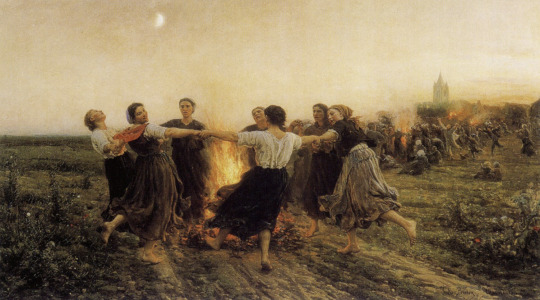
Date: 24 June
Feast day of Saint John the Baptist, hermit, prophet, baptiser. He is also the patron saint of Quebecois. It is noted that for Saint John the Baptist to coincide with the summer solstice is no accident. Summer fire festivals were celebrated in Europe long before Christianity took hold.
"He must increase, but I must decrease" (John 3:30) relates to John the Baptist indicating that he is but a forerunner for Christ’s ministry, and that his own purpose will decrease, and he will die, so that Jesus can begin His work. Parallel this to the summer solstice sun being at its strongest this time of year, only for it to start decreasing in strength in the following days, making way for the coming winter solstice sun (Christ’s birthday). Well there.
On Saint-Jean-Baptiste Day, it’s a wide celebration in Quebec, celebrating our culture, language, music, and traditions. The Acadians have chosen their own feast day, August 15th, with the Virgin Mary as their own patron saint.
As the baptiser, St. John is often associated with waters, and as such, water is the theme of the day. At dawn, collect the dew from nearby plants. This dew water can heal all ails. It is also known in some communities, that by the 24th of June, waterways become swimmable again without risk of skin rashes, since the waters were made pure by the saint. (1)
For our folk practice, it is one of my favourite holidays in the calendar, because we get to collect so many healing remedies. Many of the plants below are also called “St. John’s Herb”. Many plants are called this because they are picked at this time of year, depending on the region and the plant’s availability in the ecosystem.
The blog Courir le Loup Garou has an amazing blog post on the local herbs we can collect in Canada! (2). I use their knowledge for my own herb picking, and I commend them for their research. Most of their plant findings came from Carmen Roy’s Gaspésien remedies and oral traditions. As they caution, do not use these internally or in cataplasms until you’ve consulted a doctor or qualified herbalist. Usually I just use these plants to hang near my altar, or burn them in spells, use their parts in protection charms, etc.
The plants we can find here are:
Three-leaf goldthread/Savoyane (coptic groenlandica)
Plantain (plantago major)
Greater Burdock/Bardane (arctium lappa)
Quackgrass/Chiendent (Agropyron repens)
Yarrow/Achillée millefeuille (achillea millefolium)
According to Lyon French folklore (3), it is denotes that healing herbs are traditionally harvested the night before or early on that day before sunrise. Some of these herbs that can be found here in Canada are:
St. John’s Wort/ Millepertuis perforé (Hypericum perforatum): used to keep away bad spells and sickness.
Common Mugwort/Armoise commune (artemisia vulgaris): woven into a wreath, can preserve the home from lightning strikes and thieves.
In other parts of France, other Saint John’s Herbs are employed!
Showy stonecrop/Orpin remarquable (sedum spectabilis): In the Artois region, these are hung in a bouquet from the ceiling of a room, to inspire and bring joy.
Orpine/ Orpin reprise (sedum télephium): the cousin of the last plant, this one is woven into wreaths to hang from holy water fonts to protect against witches and protect homes. This one must also be passed through Saint-Jean-Baptiste fire smoke. This is mostly seen in the Picardie region.
Dill/Aneth fenouil (foeniculum): The sprigs of this plant, passed through Saint-Jean-Baptiste fire smoke, and harvested the morning of that day, are a great protection tool against sorcerers and evil spirits. The sprigs now split into individual twigs can be placed in floorboards, on top of door mantles, in stables, to keep pesky spirits at bay. This was especially seen in Gascony.
My plans for this year's Saint-Jean-Baptiste:
I finally booked this day off work, so I'll go traipse the woods to collect my yearly healing herbs. It'll be a day of enjoying the ocean, nature, and blessing my tools again with holy water.
Enjoy some Québecois films and music.
It's also my fiancée's birthday (I am jealous of her very magically aligned birthday, but I shouldn't groan, I'm in October).
Sources
1. https://rdaq.banq.qc.ca/expositions_virtuelles/coutumes_culture/juin/st_jean_baptiste/clin_oeil_tradition.html
2. https://courirleloupgarou.org/2019/07/09/les-herbes-de-la-saint-jean/#more-76
3. Bulletin mensuel de la Société linnéenne de Lyon, 15ᵉ année, n°7, septembre 1946, Marcel Coquillat. https://www.persee.fr/doc/linly_0366-1326_1946_num_15_7_8273
ROY, Carmen (1962). Littérature orale en Gaspésie. Ottawa, Musée national du Canada, bulletin no. 134, 389 p.
#french canadian#witchblr#quebec#folk magick#christianity#folk magic#canadian#saintjeanbaptiste#healing#protection#foraging
13 notes
·
View notes
Photo
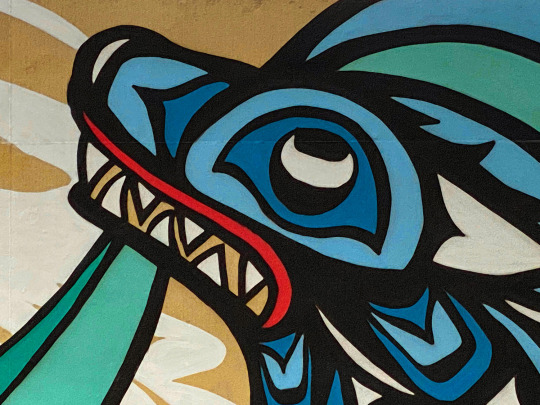
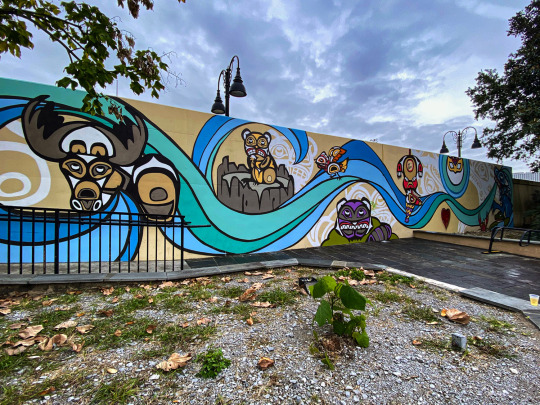
"CONNECTIONS"
Chantelle Trainor-Matties and JoLean Williams-Laborde
In 2022 the New Orleans Mayor, the Canadian Consulate, and Arts New Orleans partnered to highlight the many historic and cultural connections between Canada and Louisiana. Canadian artist Chantelle Trainor-Matties designed this depiction of the Acadians' journey south. A heavy reliance on blue and green tones depicts the importance of water to both peoples and the mural incorporates wildlife important to each, including some from their shared folklore. In New Orleans the design was painted by JoLean Williams-Laborde at Ursulines Ave and N Peters St, behind the popular French Market.
LOCATION: 1100 N Peters St, New Orleans, LA 70116
@frettchanstudios/ @jolean_barkley/ @artsneworleans/
#art#streetart#mural#NewOrleansStreetArt#ChantelleTrainor-Matties#JoLeanWilliams-Laborde#ArtsNewOrleans
13 notes
·
View notes
Photo
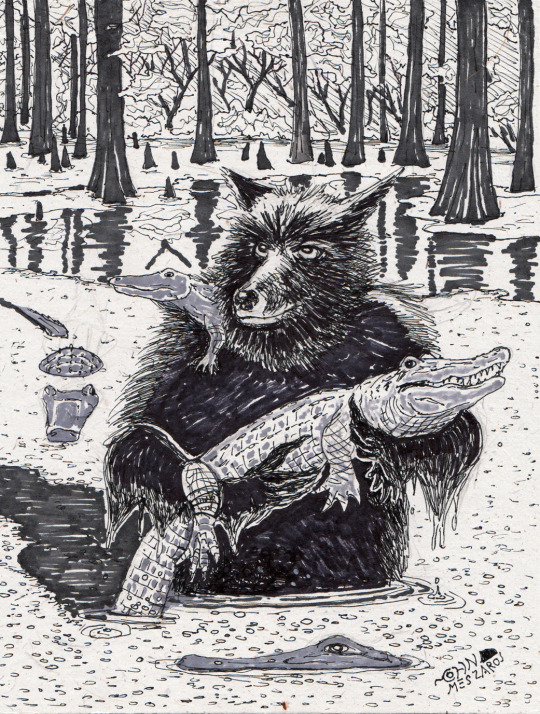
ROUGAROU- LOUISIANA
original post here: http://statecryptids.blogspot.com/2022/04/rougarou-louisiana.html
A strange, unearthly cry echoes across the mirrored surface of the Louisiana bayou, echoing off scattered cypress and tupelo dripping with Spanish moss. Is this merely the call of a wading bird? A lone puma? Or is it the shriek of the man-wolf creature known as the Rougarou?
Rougarou is a Cajun variation on “loup garou”, the French word for werewolf. France has a long history of werewolf folklore. In the 16th century these creatures were often blamed for crimes such as disappearances, animal killings, and particularly violent burglaries. In a parallel to the infamous witch hunts also taking place at the time, scared and panicked villagers would usually accuse someone living outside the societal norms of the time- such as a hermit in the woods, or a person with mental illness- as being the beast. Once accusations had been made, the condemned had little ability to defend themselves in court other than to “confess” to being a werewolf and implicate others in their ddeds.
Many legends existed to explain how one became a loup garou. Some men (medieval werewolves were almost always masculine) could change by putting on a wolf’s skin- a possible link to legends of the Norse berserker warriors who would don bear skins to take on the beast’s power. Some people would become werewolves through cannibalism and other debauchery. Catholic priests claimed that a man who didn’t observe Lent for seven straight years would become a werewolf.
Stories of the loup garou came to North America in the 17th century with French settlers in the Acadia region, located in what is now Eastern Canada. In the aftermath of the French and Indian War, the British colonial government took over the region and forcibly deported most of the ethnically French Acadians. Many of these displaced people settled in Louisiana, originally a colony of France that was ceded to Spain in 1762. The Spanish government was fairly tolerant of the settlers, allowing them to continue their cultural practices- which included tales of the loup garou.
In modern times the rougarou has become more of a boogeyman to frighten children. Parents warn their kids not to misbehave or play in the swamp or else the beast will come for them. These stories usually do not make it clear if the creature is a transformed human or if it is always a humanoid beast akin to the Beast of Bray Road and other dogmen of the Midwest.
Despite- or, more likely, because of- its frightening appearance and behavior, the Rougarou has become a popular part of Louisiana culture. Costumes based on the creature frequently appear in Mardi Gras celebrations, and the city of Houma even has an annual festival themed around the creature.
SOURCES Rougarou Fest in Houma, Louisiana A page from www.pelicanstateofmind.com about the rougarou A post from www.whereyat.com about the rougarou National Wildlife Federation article on the rougarou Article from Tulane magazine about the rougarou Blog posts from Dr. Kaja Franck about werewolves Monstrum episodes on Werewolves, hosted by Dr. Emily ZarkaPart 1Part 2
47 notes
·
View notes
Photo
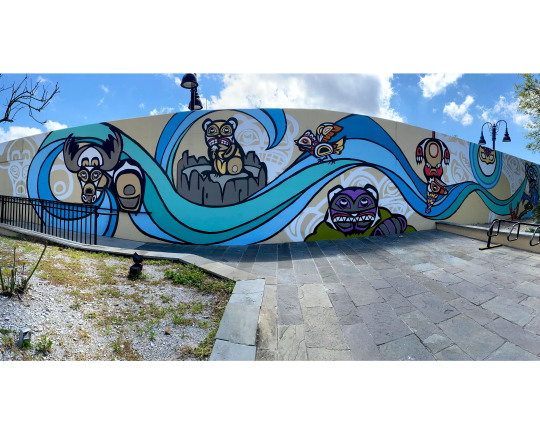
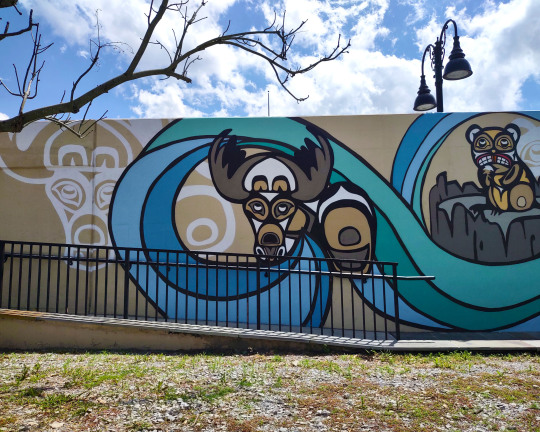
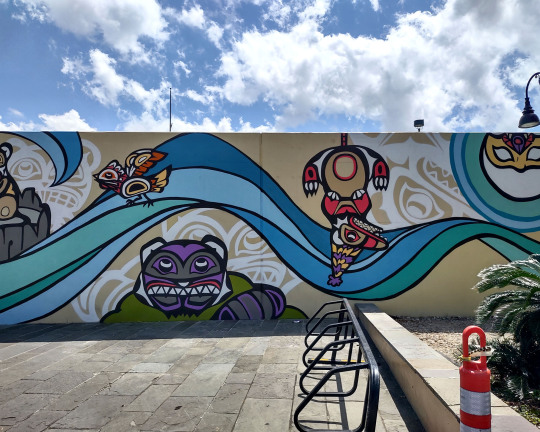
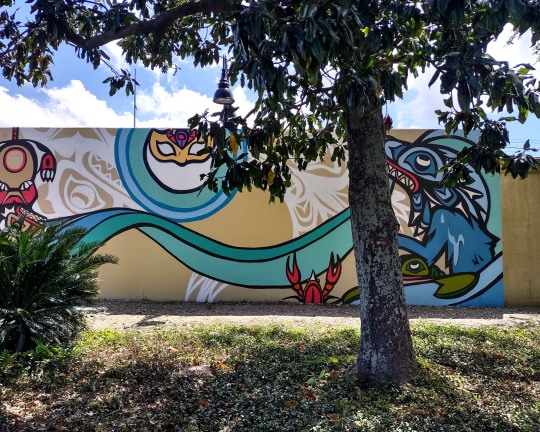

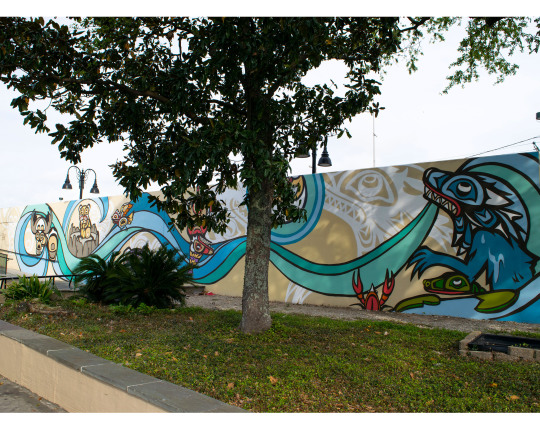
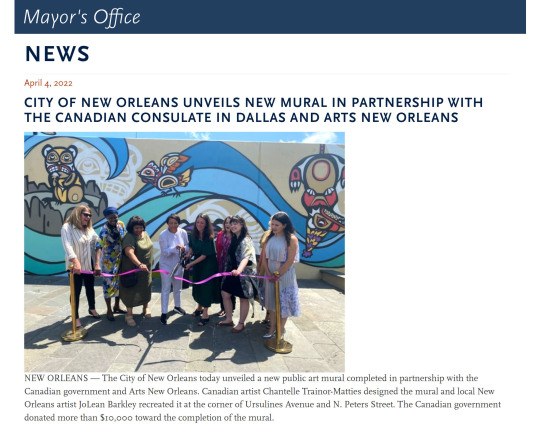
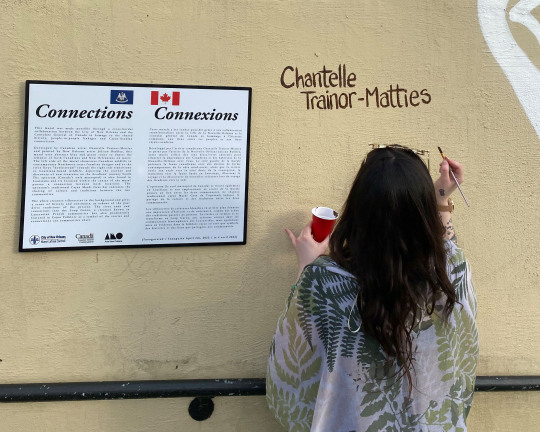


I’m honoured and humbled to have been asked to design this mural “Connections”, then painted by JoLean Barkley. The project was put together by the Consulate General of Canada @connect2canada, the Office of New Orleans Mayor Latoya Cantrell @mayorcantrell @cityofnola, and the Arts Council of New Orleans @artsneworleans. Being able to go down to celebrate the unveiling and see it in person was surreal. Mural Description: This mural uses abstract blue and green tones to depict the reliance of both Canadians and New Orleanians connection with water. The left side of the mural showcases Canadian wildlife in contemporary Northwest coast formline designs and as river flows "downstream" towards the right side transitions to Louisiana-based wildlife, depicting the journey and discovery of new creatures on the Acadians' journey South. The opossum (Canada's only marsupial) is also found in Louisiana and its location within the center of the mural proves a connection between both locations. The opossum's traditional Cajun Mardi Gras hat indicates the sharing of culture and traditions between the two communities. The white creature silhouettes in the background give a sense of history and continuity, as echos of the past drive traditions of the present. The river ends and transitions into the Loup Garou, a creature known in Laurentian French communities but also prominently featured in Cajun Folklore as a symbol of the stories and connections our communities share. Thank you, Mayor Latoya Cantrell, Mayor of New Orleans, Consul General of Canada, Dr. Rachel McCormick, @reynoldsjoycelyn, Executive Director – Arts Council New Orleans, @lindsayglatz, Creative Director - Arts Council New Orleans who coordinated the creation of the mural and liaison with artists, @prosybell1 – Director International Relations, City of New Orleans who had a key role in ensuring the proposal was approved, and Noella De Maina – Consul, Foreign Policy and Public Affairs who came up with the idea and spearheaded the project! Thank you @jolean_barkley for taking on the huge role of painting my design, you killed it! Thank you mom @cherielperry for making the trip with me, it was so special to share this with you.
Photo Credits:
Image 1, 8, 9, 10: @cherielperry
Article Screenshot: https://www.audacy.com/wwl/news/local/n-o-partners-with-the-canadian-government-to-create-a-mural
#New Orleans#Connections#Canada#Louisiana#Arts New Orleans#Public Art#Mural#Indigenous#Indigenous Art#FrettchanStudios#French Quarter#NOLA#Canadian Consulate#City of Nola#New Orleans Art#Nola Art#Canadian Art#Indigenous Artist#Mardigras#Northwest Coast Art#Contemporary Art#Wildlife#Fauna#Water#Folklore#History#River#First Nations
19 notes
·
View notes
Note
Hi I'm from eastern Texas, and getting into southern magick, is it okay if I do? And what do you recommend starting?
Thanks for the question! It can be a little tough starting out. I recommend reading about local folklore and local herbalism as a place to start. Read about (or learn directly from if possible) the indigenous peoples’ use of local plants and animals. Learn about related species and how they’re used. Spend time with the plants (and spirits) in whatever way possible.
In East Texas, I’d also recommend reading about Cajun and Acadian folks practices because they’ve heavily included the region as a whole.
I also recommend Zoe’s Neale Hurston’s work in the Journal of American Folklore, Mules and Men, and really anything she wrote whether fiction or anthropology because her fiction is so influenced by her fieldwork. Note that these are specifically on the Black Southern experience and I’m not advocating whole cloth taking of the practices found in them, but they can be really helpful in steering what you’re interested in. Also, try reading about the history of the South broadly. The South, in many ways, has far more in common with the Caribbean than much of the US, especially in our past.
I hope that’s helpful, but feel free to ask me anything else!
13 notes
·
View notes